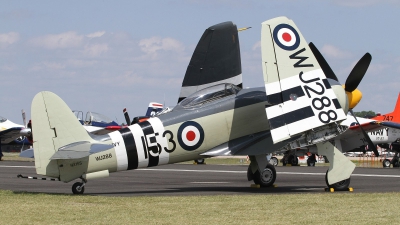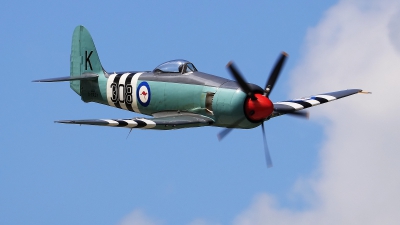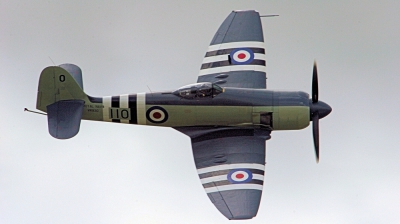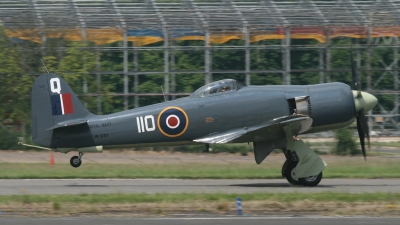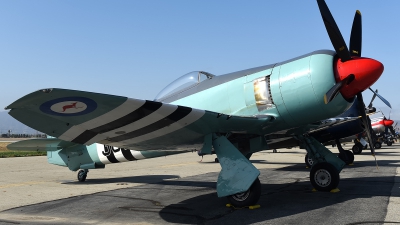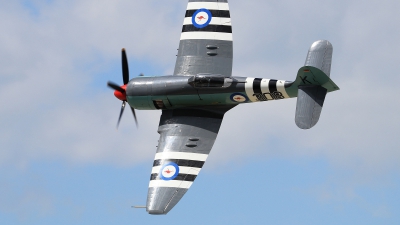Hawker Sea Fury FB11 Aircraft Data
The Hawker Sea Fury was to become the Fleet Air Arm's last piston-engined fighter. Development had started in 1943, for the Royal Air Force (RAF), intended as a successor of their highly successful Typhoon and Tempest fighters.
An Air Ministry Specification F.6/42 had been issued on 7 September 1942 and called for a single-seat (light) fighter aircraft. Submitted designs included a modified version of the Hawker Tempest: the Tempest Light Fighter, to be powered by a Bristol Centaurus radial engine. Some time later, the Admiralty also issued a specification for lightweight single-seat aircraft (Specification N.7/43). Hawkers succeded convincing the Admiralty and te Ministry of Aircraft Production that their proposal of their design with a Centaurus XII was capable of fulfilling both specifications, resulting in the issue of a new specification pooled under Specification F.2/43, dated 14 May 1943. Hawkers would work on the Royal Air Force design named the Fury and Boulton Paul Aircraft Ltd at Wolverhampton would undertake the conversion of the aircraft conforming to naval standards (Specification N.22/43), named the Sea Fury.
The first two F.2/43 Fury prototypes for the RAF, NX798 and NX802, were ordered on 27 March 1943. Although the Centaurus XII radial was envisaged as the main powerplant for the Fury/Sea Fury, other engines were considered, as had also been the case with the Tempest. By December 1943 three prototypes were on order, of which one was to be powered by a Bristol Centaurus XII (NX798), one to be powered by the Bristol Centaurus XV (NX802) and one fitted with a Rolls Royce Griffon engine (LA610). On 27 February 1946 two other prototypes to Specification F.2/43 were ordered. These two were serialled VP207 and VP213. Early in 1944, the naval prototypes were ordered: on 24 February 1944 the order for two prototypes to Specification N.22/43 (SR661 and SR666) a month later, on 22 March, to be followed by the order for one F.X also to Specification N.22/43 (serial VB857).
1. NX798 (F.2/43) Fury prototype: first flight on 1 September 1944, fitted with a Centaurus XII and 4-bladed Rotol propeller; later re-engined with a Centaurus XVIII and 4-bladed Rotol and first flew in this configuration on 19 March 1946.
2. LA610 (F.2/43) Fury prototype: first flight on 27 November 1944, with a Griffon 85 and two contra-rotating three-bladed Rotol propellers. LA610 had originally been ordered as a Tempest III. It was refitted with a Napier Sabre VII and made her first flight with this engine on 5 February 1945.
3. NX802 (F.2/43) Fury prototype: first flight on 25 July 1945, with Centaurus XV and 4-bladed propeller. Later re-engined with a Centaurus XVIII and 5-bladed Rotol propeller.
4. SR661 (N.22/43) Sea Fury prototype. This semi-navalised aircraft was powered by a Centaurus XII and four-bladed propeller. First flight on 21 Februari 1945. Soon after, the aircraft was fitted with a Centaurus XV with 5-bladed propeller.
5. SR666 (N.22/43) Sea Fury prototype. Fully navalised, with folding wings and Centaurus XV with 5-bladed Rotol propeller. First flight on 12 October 1945. Later a Centaurus XVIII was fitted.
6. VB857 Sea Fury F.X prototype. Fully navalised with Centaurus XV and 5-bladed propeller. First flight on 31 January 1946.
7. VP207 Fury prototype: first flight on 9 May 1947. This aircraft was built from stock parts. Fitted with the Napier Sabre VII to become the second prototype with this engine after LA610 had been refitted with the Sabre.
8. VP213 Fury prototype. Although production was commenced, the aircraft was not completed.
During April 1944 production contracts were placed for 200 Fury I aircraft for the RAF and an equal number of Sea Fury aircraft for the Fleet Air Arm, of which 100 were to be built by Boulton Paul Aircraft Ltd. A few months later, with the Allied armies gaining a strong foothold in France after the D-Day landings and with the end of the World War II in Europe in sight, the production order for the RAF Fury was cancelled. The Royal Navy however considered the aircraft a suitable replacement for its ageing carrier borne fighters and pressed for continuation of the development of the Sea Fury.
The first production model, Sea Fury F.X* TF895 on 15 August 1946 and by early 1947 the first F.10 had been delivered to No.778 Squadron at RNAS Ford for intensive Service flying trials. In May 1947 No.787 Squadron, the Naval Air Fighting Development Unit of the Central Fighter Establishment at RAF West Raynham accepted their first F.10 aircraft.
In August 1947 No.803 Squadron (Royal Canadian Navy) at RNAS Eglinton, Northern Ireland, became the first operational Sea Fury unit, shortly to be followed by No.807 Squadron RNAS Culdrose). The last two units to be equipped with the F.10 were No.802 Squadron at RNAS Lee-on-Solent and No.805 Squadron (Royal Australian Navy) at RNAS Eglinton.
By the end of 1948 the F.10 was removed from front line operations to be replaced by the FB.11.
*) In June 1948 the F.X was redesignated F.10.
Sea Fury FB.11 production and serials
The total production of the FB.11 was covered by 9 contract blocks and totalled 468 aircraft, this figure excluding the three prototypes SR661, SR666 and VB857:
TF956-973, TF985-999, TG113-TG129 (50 a/c).
VR918- 952 (35 a/c).
VX608-643, VX650-696, VX707-711, VX724-730, VX748-764, WF-610-WF627 (135 a/c).
WE673-694, WE708-736, WE785-806, WM472-482, WM487-WM495 (93 a/c).
WG564-575, WG590-604, WG621-630 (37 a/c).
WH581-594, WH612-623, WJ221-248, WJ276-292, WJ294-297, WJ229-301 (78 a/c).
WN474-479, WN484-487 (10 a/c).
WZ627-656 (30 a/c).
An Air Ministry Specification F.6/42 had been issued on 7 September 1942 and called for a single-seat (light) fighter aircraft. Submitted designs included a modified version of the Hawker Tempest: the Tempest Light Fighter, to be powered by a Bristol Centaurus radial engine. Some time later, the Admiralty also issued a specification for lightweight single-seat aircraft (Specification N.7/43). Hawkers succeded convincing the Admiralty and te Ministry of Aircraft Production that their proposal of their design with a Centaurus XII was capable of fulfilling both specifications, resulting in the issue of a new specification pooled under Specification F.2/43, dated 14 May 1943. Hawkers would work on the Royal Air Force design named the Fury and Boulton Paul Aircraft Ltd at Wolverhampton would undertake the conversion of the aircraft conforming to naval standards (Specification N.22/43), named the Sea Fury.
The first two F.2/43 Fury prototypes for the RAF, NX798 and NX802, were ordered on 27 March 1943. Although the Centaurus XII radial was envisaged as the main powerplant for the Fury/Sea Fury, other engines were considered, as had also been the case with the Tempest. By December 1943 three prototypes were on order, of which one was to be powered by a Bristol Centaurus XII (NX798), one to be powered by the Bristol Centaurus XV (NX802) and one fitted with a Rolls Royce Griffon engine (LA610). On 27 February 1946 two other prototypes to Specification F.2/43 were ordered. These two were serialled VP207 and VP213. Early in 1944, the naval prototypes were ordered: on 24 February 1944 the order for two prototypes to Specification N.22/43 (SR661 and SR666) a month later, on 22 March, to be followed by the order for one F.X also to Specification N.22/43 (serial VB857).
1. NX798 (F.2/43) Fury prototype: first flight on 1 September 1944, fitted with a Centaurus XII and 4-bladed Rotol propeller; later re-engined with a Centaurus XVIII and 4-bladed Rotol and first flew in this configuration on 19 March 1946.
2. LA610 (F.2/43) Fury prototype: first flight on 27 November 1944, with a Griffon 85 and two contra-rotating three-bladed Rotol propellers. LA610 had originally been ordered as a Tempest III. It was refitted with a Napier Sabre VII and made her first flight with this engine on 5 February 1945.
3. NX802 (F.2/43) Fury prototype: first flight on 25 July 1945, with Centaurus XV and 4-bladed propeller. Later re-engined with a Centaurus XVIII and 5-bladed Rotol propeller.
4. SR661 (N.22/43) Sea Fury prototype. This semi-navalised aircraft was powered by a Centaurus XII and four-bladed propeller. First flight on 21 Februari 1945. Soon after, the aircraft was fitted with a Centaurus XV with 5-bladed propeller.
5. SR666 (N.22/43) Sea Fury prototype. Fully navalised, with folding wings and Centaurus XV with 5-bladed Rotol propeller. First flight on 12 October 1945. Later a Centaurus XVIII was fitted.
6. VB857 Sea Fury F.X prototype. Fully navalised with Centaurus XV and 5-bladed propeller. First flight on 31 January 1946.
7. VP207 Fury prototype: first flight on 9 May 1947. This aircraft was built from stock parts. Fitted with the Napier Sabre VII to become the second prototype with this engine after LA610 had been refitted with the Sabre.
8. VP213 Fury prototype. Although production was commenced, the aircraft was not completed.
During April 1944 production contracts were placed for 200 Fury I aircraft for the RAF and an equal number of Sea Fury aircraft for the Fleet Air Arm, of which 100 were to be built by Boulton Paul Aircraft Ltd. A few months later, with the Allied armies gaining a strong foothold in France after the D-Day landings and with the end of the World War II in Europe in sight, the production order for the RAF Fury was cancelled. The Royal Navy however considered the aircraft a suitable replacement for its ageing carrier borne fighters and pressed for continuation of the development of the Sea Fury.
The first production model, Sea Fury F.X* TF895 on 15 August 1946 and by early 1947 the first F.10 had been delivered to No.778 Squadron at RNAS Ford for intensive Service flying trials. In May 1947 No.787 Squadron, the Naval Air Fighting Development Unit of the Central Fighter Establishment at RAF West Raynham accepted their first F.10 aircraft.
In August 1947 No.803 Squadron (Royal Canadian Navy) at RNAS Eglinton, Northern Ireland, became the first operational Sea Fury unit, shortly to be followed by No.807 Squadron RNAS Culdrose). The last two units to be equipped with the F.10 were No.802 Squadron at RNAS Lee-on-Solent and No.805 Squadron (Royal Australian Navy) at RNAS Eglinton.
By the end of 1948 the F.10 was removed from front line operations to be replaced by the FB.11.
*) In June 1948 the F.X was redesignated F.10.
Sea Fury FB.11 production and serials
The total production of the FB.11 was covered by 9 contract blocks and totalled 468 aircraft, this figure excluding the three prototypes SR661, SR666 and VB857:
TF956-973, TF985-999, TG113-TG129 (50 a/c).
VR918- 952 (35 a/c).
VX608-643, VX650-696, VX707-711, VX724-730, VX748-764, WF-610-WF627 (135 a/c).
WE673-694, WE708-736, WE785-806, WM472-482, WM487-WM495 (93 a/c).
WG564-575, WG590-604, WG621-630 (37 a/c).
WH581-594, WH612-623, WJ221-248, WJ276-292, WJ294-297, WJ229-301 (78 a/c).
WN474-479, WN484-487 (10 a/c).
WZ627-656 (30 a/c).
- Country of Origin: United Kingdom
- First Flight: 30 September 1946
- Initial Service Date: August 1947
- No. Built: 468
- No. In Service: 0
- No. of Hardpoints: 4
- Crew: 1
Power:
Bristol Centaurus XVIII at 2,480 hp
Weapons:
Four 20mm Hispano-Suiza HS.404 Mk.5 cannon with 145 rounds each.
Eight 60lb 3 inch Rocket Projectiles or four 180lb Triplex RPs or
two 1,000lb or 500 lb bombs or napalm canisters.
Eight 60lb 3 inch Rocket Projectiles or four 180lb Triplex RPs or
two 1,000lb or 500 lb bombs or napalm canisters.
Dimensions:
| Length: | 34 ft 8 in. |
| Wing Span: | 34 ft 4¾ in. |
| Wing Area: | 280 sq.ft |
| Height: | 15 ft 10 in. |
| Empty Weight: | 9,240 lbs |
| Max. Weight: | 14,650 lbs |
| Internal Fuel: | 1,489 lbs |
Performance:
| Max. Speed: | 460 mph |
| Service Ceiling: | 35,800 ft. |
| Normal Range: | 609 nm |
| Max. Range: | 1,390 nm |
Operators:
AustraliaThe Royal Australian Navy received 99 Sea Furies, diverted from Royal Navy contracts. Three front-line units were formed to operate the FB.11:
No.805 Squadron
No.808 Squadron
No.850 Squadron
Three second-line RAN units had the FB.11 on strength:
No.723 Squadron
No.724 Squadron
No.725 Squadron
Burma (now Myanmar)
The Burmese Air Force received 18 Sea Fury FB.11s from the Fleet Air Arm, as well as three T.20s for conversion and continuation training. Three FB.11s were modified for target towing. Unlike other conversions to target towing duties, these Sea Furies had no winch system fitted. The target banners were attached to the tail hooks. They were known as TT.11s.
Canada
Initially Canada obtained 35 FB.11s from Royal Navy Fleet Air Arm production for use by two Royal Canadian Navy units:
No.803 Squadron (renumbered No.870 Squadron on 1 May 1951).
No.883 Squadron (renumbered No.871 Squadron on 1 May 1951).
A year later the RCN adopted a US Navy designation system and became known as VF-870 and VF-871.
No.803 had been equipped with 13 Sea Fury F.10s in August 1947 on loan from the Fleet Air Arm to speed up transition to the Sea Fury, before the first FB.11s arrived in late May 1948. These F.10s never carried Canadian markings.
In total the RCN obtained 64 Sea Fury FB.11s.
Cuba
Cuba obtained 15 ex-FAA Sea Fury FB.11s as well as three T.20s.
Germany
The Deutsche Luftfahrtberatungsdienst (DLB) at Lübeck-Blankensee operated 16 Sea Fury T.20s and one FB.11 between 1958 and 1960. The FB.11 was former FAA WG599. She became D-CACY in DLB-service. Since 7 September 2017, she is registered G-SEAF to Patina Ltd (The Fighter Collection) at Duxford.
Iraq
Apart from 30 new-built single-seat aircraft, known as Iraqi Single Seaters (ISS), the Iraqi Air Force placed an additional order for 25 aircraft on 21 July 1951, of which the first 15 were new-built, with the other 10 coming from Fleet Air Arm stocks.
Netherlands
On 21 October 1946 the Dutch Government placed an order for ten Sea Fury F.10s for service on their aircraft carrier Hr. Ms. Karel Doorman (previously HMS Venerable). These aircraft were designated Sea Fury F.50 in Marine Luchtvaart Dienst (MLD) service. In May and June 1948, these ten aircraft were flown to Valkenburg NAS for service with No.860 Squadron.
A second order, placed on 12 January 1950, was for twelve Sea Fury FB.11 fighter-bombers, to enter Dutch service under the designation of Sea Fury FB.60. After that Hawkers received an order for conversion of the remaining F.50s of the first order to FB.60 standard.
Another 25 aircraft were built under licence by Fokker. These were designated Sea Fury FB.51 in Dutch service.
Pakistan
In 1953-54 the Pakistani Air Force received 5 Fleet Air Arm Sea Fury FB.11 to complement an earlier order of 87 Sea Fury FB.60 aircraft. The Sea Furies equipped three front line squadrons:
No. 5 Squadron
No.9 Squadron
No.14 Squadron
United Kingdom
The Royal Navy's Fleet Air Arm had eight front line units operating the Sea Fury FB.11:
No.801 Squadron
No.802 Squadron
No.803 Squadron*
No.804 Squadron
No.805 Squadron**
No.806 Squadron
No.807 Squadron
No.810 Squadron
No.811 Squadron
*) No.803 Squadron was a Royal Canadian Navy unit, based at RNAS Eglinton, Northern Ireland, initially equipped with the Sea Fury F.10.
**) Royal Australian Navy, RNAS Eglinton.
Second-line FAA squadrons operating the FB.11:
No.700 Squadron
No.703 Squadron
No.736 Squadron
No.738 Squadron
No.739 Squadron
No.744 Squadron
No.759 Squadron
No.767 Squadron
No.773 Squadron
No.778 Squadron
No.781 Squadron
No.782 Squadron
No.787 Squadron
No.799 Squadron
Four units of the Royal Naval Volunteer Reserve had the FB.11 on strength:
No.1831 Squadron
No.1832 Squadron
No.1833 Squadron
No.1834 Squadron
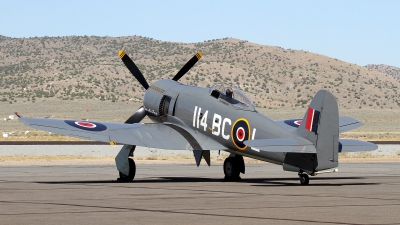
 Random great photos of the Hawker Sea Fury FB11:
Random great photos of the Hawker Sea Fury FB11:
